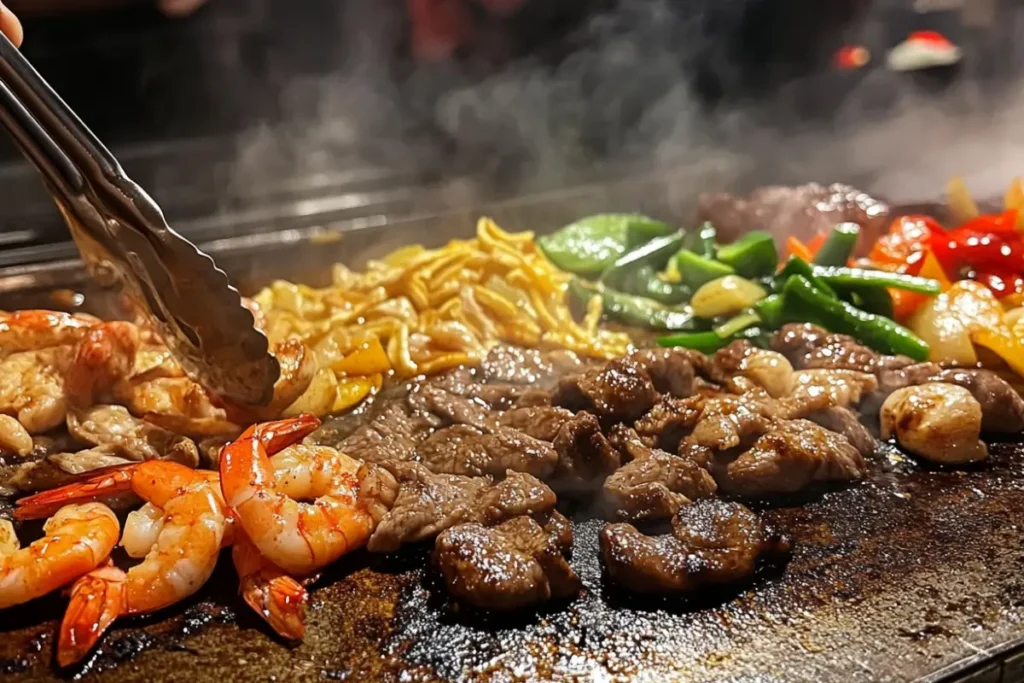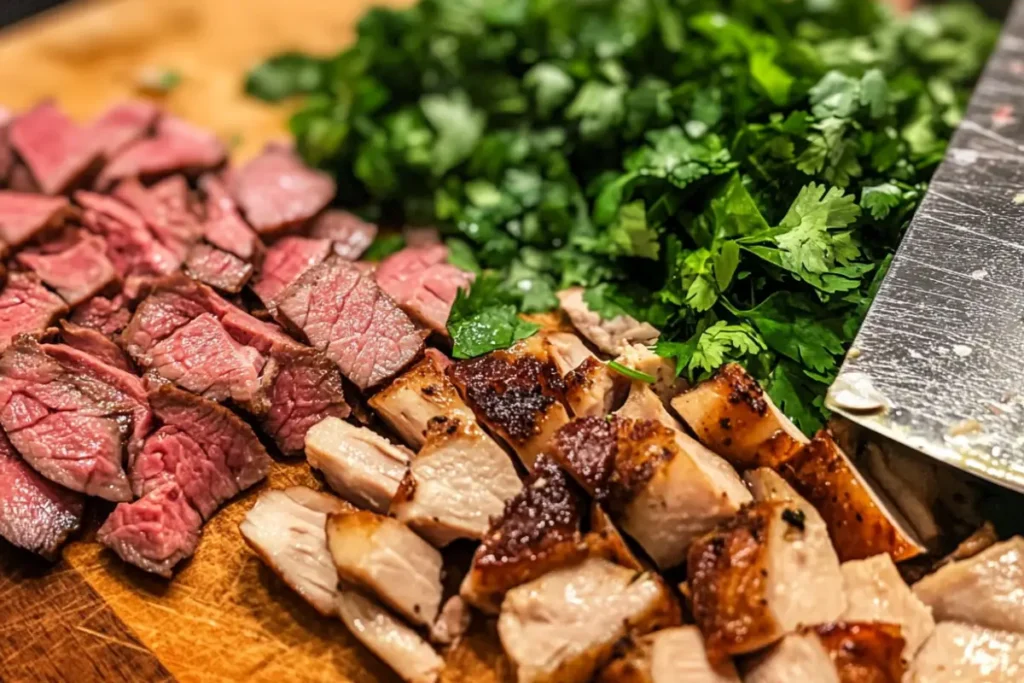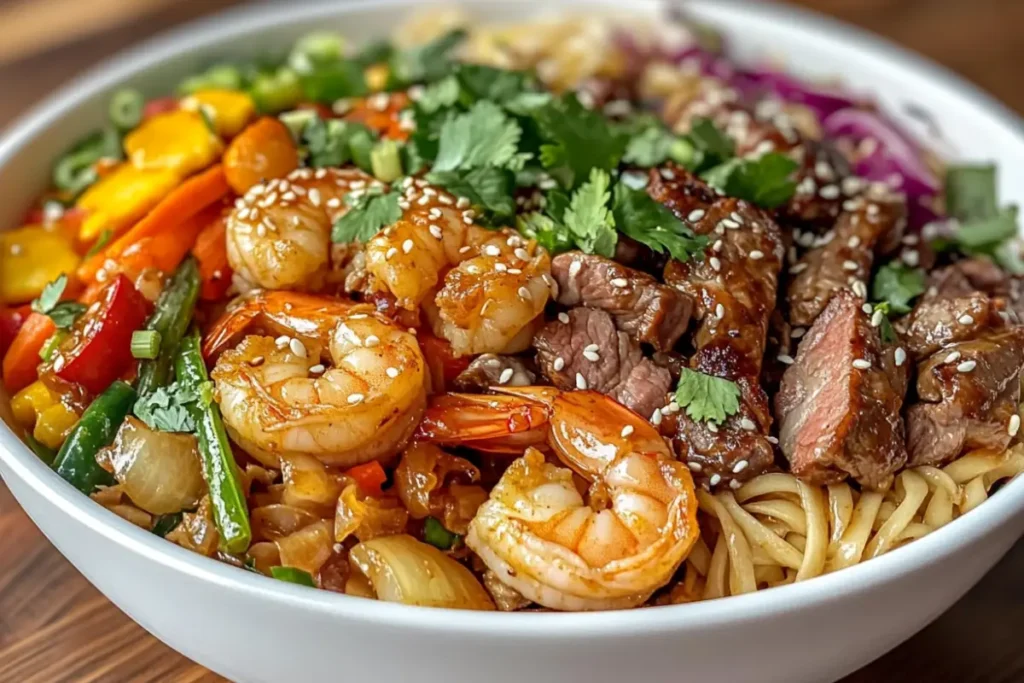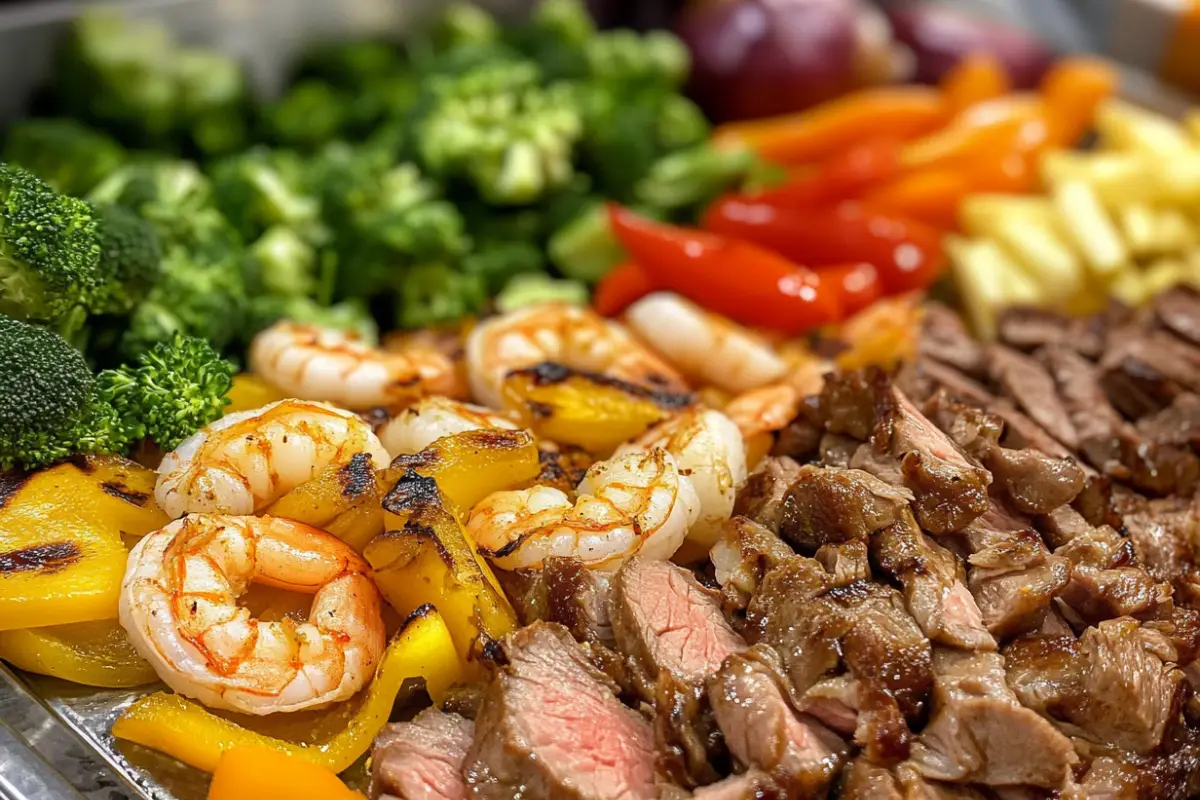Last Updated on February 12, 2025 by Souhail
If you’ve ever watched the sizzling spectacle of Mongolian barbecue, you’ve likely been mesmerized by the vibrant mix of ingredients on the griddle. At the heart of this interactive dining experience lies the meat kind in Mongolian barbecue, which plays a crucial role in the flavor, texture, and overall satisfaction of the dish. Whether you’re a seasoned foodie or exploring this for the first time, understanding the different kinds of meat used in Mongolian barbecue adds depth to your appreciation of this unique culinary art.
Mongolian barbecue, despite its name, isn’t actually Mongolian in origin. It was developed in Taiwan and draws inspiration from stir-fry and grilling techniques. The true magic happens on a large, flat iron griddle, where your selected meats, vegetables, and sauces come together to create a harmonious, flavor-packed dish.
With its bold flavors, sizzling sounds, and endless customizability, Mongolian barbecue offers something for everyone. Choosing the right meat kind in Mongolian barbecue—whether it’s beef, chicken, seafood, or even lamb—can elevate the experience and ensure every bite is perfectly balanced.
Table of contents
Types of Meat in Mongolian Barbecue
1. Beef
Beef is one of the most popular choices in Mongolian barbecue. The thinly sliced cuts, typically flank steak or sirloin, cook quickly on the griddle and absorb the bold flavors of soy-based sauces, garlic, and ginger.
- Why it works: Beef has a robust flavor that pairs beautifully with the sweet and savory sauces used in Mongolian barbecue. The marbling in some cuts adds richness, while the thin slices ensure even cooking.
- Customizations: For a spicier kick, pair beef with chili paste or crushed red pepper.
2. Chicken
Chicken is a lighter option often favored for its versatility. Boneless, skinless chicken breast or thigh meat is commonly used because it’s easy to slice thin and cooks quickly.
- Why it works: Chicken is like a blank canvas, taking on the flavors of the sauces and spices you choose. It’s also a great choice for those looking for a leaner protein.
- Customizations: Pair chicken with citrusy sauces like orange or lemon to brighten the dish.
3. Lamb
Though less common, lamb is a traditional choice in some regions, reflecting the dish’s loose association with Mongolian cuisine. Lamb’s bold, gamey flavor stands up well to the strong spices and sauces.
- Why it works: Lamb adds a unique, earthy flavor that’s perfect for adventurous eaters. It pairs well with cumin, garlic, and chili.
- Customizations: Try adding a touch of sesame oil or mint-based sauces for a unique twist.
4. Seafood (Shrimp, Scallops, or Fish)
Seafood is often offered as a lighter, more delicate alternative to red meats and poultry. Shrimp, scallops, and thin white fish like tilapia or cod are popular choices.
- Why it works: Seafood cooks quickly and absorbs the sauce’s flavors without losing its own natural sweetness. It’s perfect for those seeking a low-calorie, high-protein option.
- Customizations: Pair seafood with light, citrus-based sauces or a sprinkle of fresh herbs like cilantro.
5. Tofu (Plant-Based Option)
While not technically a meat, tofu is a staple for vegetarians and vegans at Mongolian barbecue restaurants. Its firm texture holds up well on the griddle, and it absorbs sauces much like meat.
- Why it works: Tofu is neutral in flavor, allowing the sauces and seasonings to shine. It’s also a great source of plant-based protein.
- Customizations: Combine tofu with sesame oil and a touch of chili sauce for a spicy, nutty flavor profile.
Pro Tips for Choosing the Best Meat

- Think About Cooking Time:
Thinly sliced meats work best because they cook quickly and evenly. Avoid thick cuts that may not cook through properly on the griddle. - Consider Marbling:
For red meats like beef and lamb, look for cuts with good marbling for added richness and flavor. - Match Meat to Sauce:
Pair lighter meats like chicken or seafood with citrusy or mild sauces, and bolder meats like beef or lamb with strong, savory sauces. - Experiment with Combinations:
Don’t be afraid to mix and match meats. A combination of beef and shrimp, for example, offers a surf-and-turf experience.
Nutritional Benefits of Meat in Mongolian Barbecue
Mongolian barbecue is not just a feast for the taste buds—it can also provide a nutritious and balanced meal, depending on your choice of meat and portion sizes. Each type of meat offers unique nutritional benefits, making it easy to customize your meal to meet specific dietary goals.
1. Beef
Beef is a powerhouse of protein and iron, particularly lean cuts like sirloin or flank steak commonly used in Mongolian barbecue.
- Nutritional Highlights:
- High in protein to support muscle growth and repair.
- Rich in iron, which helps transport oxygen in the blood.
- Contains zinc and vitamin B12 for immune and neurological health.
2. Chicken
Chicken, especially boneless, skinless breast, is a lean protein option that’s low in fat and calories.
- Nutritional Highlights:
- A great source of lean protein, perfect for weight management or building muscle.
- High in niacin, which supports skin and nerve health.
- Low in saturated fat compared to red meats.
3. Lamb
While higher in fat than some other meats, lamb provides a robust source of nutrients.
- Nutritional Highlights:
- Packed with iron and zinc.
- Contains healthy omega-3 fatty acids in grass-fed varieties.
- A good source of vitamin B6, which aids brain health and energy production.
4. Seafood
Seafood like shrimp or fish is low in calories and packed with essential nutrients.
- Nutritional Highlights:
- Shrimp is high in protein and contains iodine for thyroid health.
- Fatty fish like salmon (if offered) are rich in heart-healthy omega-3s.
- Low in calories, making it ideal for lighter meals.
By balancing your chosen meat with a variety of vegetables, Mongolian barbecue becomes a meal rich in protein, fiber, vitamins, and minerals. Pairing your meat with nutrient-dense vegetables like broccoli, spinach, or bell peppers enhances the overall health benefits while keeping the dish flavorful and satisfying.
How to Slice and Prep Meat for Mongolian Barbecue

Perfectly prepped meat is the foundation of a successful Mongolian barbecue experience. The texture, cooking time, and ability to absorb sauces all depend on how you slice and prepare your meat. Here are some expert tips to ensure your cuts are flawless every time:
1. Choose the Right Cut of Meat
Opt for tender cuts that can be sliced thinly and cook quickly. Some top choices include:
- Beef: Flank steak, sirloin, or ribeye.
- Chicken: Boneless, skinless breast or thigh.
- Lamb: Leg or loin.
2. Freeze for Easy Slicing
Place your meat in the freezer for 20–30 minutes before slicing. This firms up the texture, making it easier to achieve thin, even slices.
3. Slice Against the Grain
Cutting against the grain (perpendicular to the muscle fibers) ensures tender bites. This technique is especially important for beef and lamb.
4. Aim for Uniform Thickness
Keep slices about 1/8 to 1/4 inch thick. Uniform pieces cook evenly on the hot griddle, preventing overcooking or undercooking.
5. Marinate for Flavor and Tenderness
For enhanced flavor, marinate your meat for 15–30 minutes before cooking. Use a blend of soy sauce, sesame oil, garlic, and ginger for a traditional Mongolian barbecue taste.
- Tip: Avoid over-marinating, as acidic ingredients like vinegar or citrus can break down the meat too much.
6. Use a Sharp Knife or Meat Slicer
A sharp blade is essential for clean, even cuts. If you frequently prepare Mongolian barbecue at home, investing in a meat slicer can save time and effort.
By preparing your meat with care, you’ll create a dish that’s not only delicious but also visually appealing and perfectly cooked.
Common Mistakes to Avoid When Selecting Meat
Selecting the wrong type of meat or mishandling it can turn your Mongolian barbecue experience into a culinary flop. Here are the most common mistakes to avoid and how to fix them:
1. Using Thick Cuts
Thicker cuts of meat take longer to cook and may not fully caramelize on the hot griddle, resulting in unevenly cooked bites.
- Solution: Always slice your meat thinly to ensure quick, even cooking.
2. Choosing Tough or Chewy Cuts
Some cuts, like brisket or stew meat, are too tough for Mongolian barbecue’s quick cooking process.
- Solution: Stick to tender cuts like sirloin, flank steak, or tenderloin.
3. Over-Marinating the Meat
While marinades add flavor, leaving meat in a marinade for too long can break down the proteins and create a mushy texture.
- Solution: Limit marinating time to 30 minutes, especially for thin slices.
4. Skipping the Prep Step
Failing to freeze meat briefly before slicing can lead to uneven cuts and inconsistent cooking.
- Solution: Freeze your meat for about 20 minutes to make slicing easier.
5. Ignoring Fat Content
Choosing overly fatty cuts can result in greasy, heavy bites, while excessively lean cuts might dry out.
- Solution: Select cuts with moderate marbling for the best balance of flavor and tenderness.
6. Not Considering Sauce Pairings
Some meats don’t pair well with certain sauces, leading to an unbalanced flavor profile.
- Solution: Match your meat with complementary sauces. For instance, lamb pairs beautifully with cumin and garlic, while seafood works best with citrus or soy-based sauces.
Avoiding these common pitfalls ensures that your Mongolian barbecue is a success every time, delivering juicy, flavorful, and perfectly cooked meat.
Variants of Mongolian Barbecue
- All-Seafood Mongolian Barbecue:
Focuses solely on shrimp, scallops, and fish, offering a light and flavorful dish. - Vegetarian Mongolian Barbecue:
Replaces meat with tofu, seitan, or tempeh, along with an array of vegetables for a plant-based meal. - Spicy Mongolian Barbecue:
Incorporates chili paste, Szechuan peppers, or hot sauces for those who love heat. - Fusion Mongolian Barbecue:
Combines traditional ingredients with global flavors, such as using teriyaki sauce or adding pineapple.
Serving Suggestions

Mongolian barbecue is best served fresh off the griddle. Pair it with:
- Steamed White Rice: A classic side that absorbs the flavorful sauces.
- Fried Rice or Noodles: For a heartier meal.
- Pickled Vegetables: These add a tangy contrast to the rich flavors of the meat.
- Side Salad: A crisp salad with a light vinaigrette balances the meal.
FAQs About Meat in Mongolian Barbecue
Yes, but thaw it completely and slice it thinly for best results.
Flank steak or sirloin works best due to their balance of tenderness and flavor.
While not as common as beef or chicken, lamb is offered at some traditional or upscale establishments.
Absolutely! Many places offer tofu or plant-based proteins along with a wide variety of vegetables.
Mongolian barbecue is more than just a meal—it’s an experience that combines vibrant flavors, sizzling sounds, and endless customization options. The variety of meats available, ranging from tender beef and juicy chicken to bold lamb and delicate seafood, ensures there’s truly something for everyone. Furthermore, by carefully selecting the right cuts, thoughtfully preparing them, and skillfully pairing them with complementary sauces, you can easily elevate your Mongolian barbecue to a restaurant-quality dish right in the comfort of your own home.
Whether you’re planning a family dinner, a fun date night, or a solo culinary adventure, Mongolian barbecue is a fantastic choice. Its balance of nutrition, flavor, and versatility makes it a favorite among food lovers of all ages and preferences. Plus, with its interactive nature, it’s an excellent way to engage everyone in the cooking process.
Ready to take your Mongolian barbecue to the next level? If so, be sure to check out The Ultimate Mongolian Grill Recipe for DIY Stir-Fry Nights for an in-depth guide to crafting the perfect stir-fry at home. Not only is it packed with tips, but it also includes step-by-step instructions and customizable ideas. In fact, it’s the only guide you’ll ever need to effortlessly recreate the sizzling magic of Mongolian barbecue in your kitchen.

